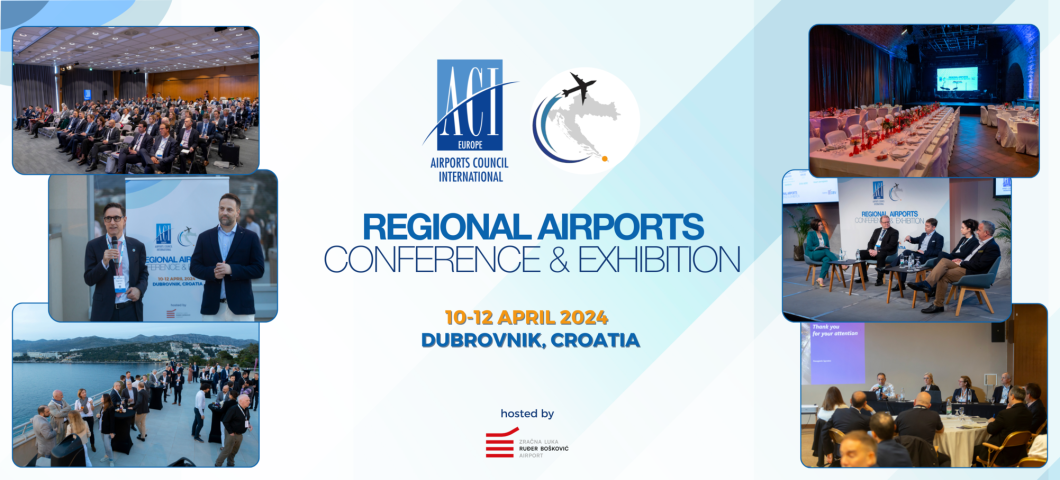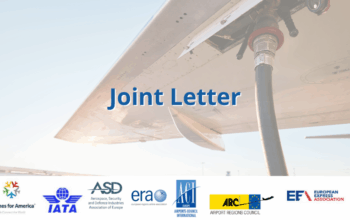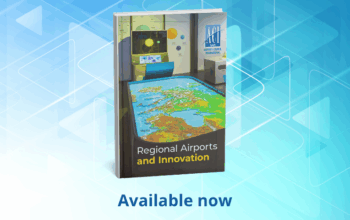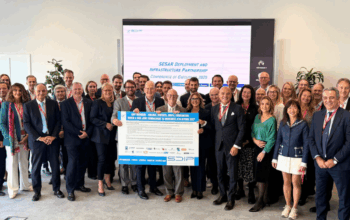
Regional airports – a story of resilience against all odds
The 14th edition of ACI EUROPE’s Regional Airports Conference & Exhibition hosted by Ruđer Bošković Airport in Dubrovnik, Croatia was an opportunity for regional airport leaders to come together and address a slew of challenges looming large for Europe’s regional air transport. Reshaped market dynamics, decarbonisation and stunted financial viability topped the agenda.
Competitive pressures tighten grip
Europe’s air connectivity is still recovering from the shock of COVID-19. The steady traffic increases have largely been driven by leisure and VFR demand mix, creating a perfect environment for Ultra-Low Cost Carriers to thrive. This trend is especially visible at regional airports where Ultra-LCCs are increasing seat capacity by +15.3% this Summer, compared to Network Carriers taking out -24.5% of their seats in this market segment. Whilst a boon for enhancing point-to-point connectivity, the expansion of LCCs at regional airports inadvertently means lower yields for airports, as these airlines have a tendency to move shop as soon as better conditions (i.e. larger rebates) appear at another airport. Their footloose model is tightening the competitive grip on regional airports, and pushing revenues from user charges below break-even. These charges have been on a steady decline in real terms over the past 5 years, reaching an all-time low in 2024 and resulting in precarious financials for Europe’s regional airports.
Joe Gilmore, Managing Director of Ireland West Airport explained during his presentation: “As a small regional airport, your ability to manage cost is extremely limited. We have the same costs as any larger airport and the same safety and maintenance requirements, but much less revenue potential. At Ireland West, we had a 40% spike in costs in the past years and for entirely external reasons – inflation, staffing costs, and commodities. At the same time, we need to provide a very cost-effective service, because that’s why our customers use us. Competition for business is extremely aggressive.”
Quoting Kata Cserep, Global Aviation Lead in PA Consulting, on her key takeaway from being MoC of this year’s Regional Airports Conference: “Running a regional airport is challenging; running a small regional airport is downright precarious.”
Turbocharge sustainability – regional aviation’s core mission
All this at a time when investing in decarbonisation is an absolute priority for European aviation. Regional airports are playing a key role in the development of clean aviation, serving as a test bed for electric and hybrid electric aircraft, looking at local generation of new fuels and redefining air connectivity. It’s all the more vital then that their financial sustainability is considered a matter of priority by governments and policymakers. Research from Oxera on the impact of the EU Fit for 55 rings the alarm for regional airports, as the cumulative effect could result in wiping out up to 20% of their passenger traffic. Against all odds, regional airports keep their eyes on their core mission to deliver sustainable connectivity for communities that they serve. A case in point – 9 out of 10 airports globally who pioneered the new topmost level of Airport Carbon Accreditation – Level 5 – which certifies airports for reaching a net zero carbon balance, are regional.
Delegates gathered in Dubrovnik heard from trailblazer airports charting the path forward for new sustainable technologies to power the future of net zero air transport. Amongst them was Groningen Airport Eelde developing the world’s first hydrogen valley airport. Meiltje de Groot, the CEO of GRQ highlighted the importance of collaboration and connecting to regional strengths and ambitions – their hydrogen valley project, while a brainchild of the forward-thinking management at Groningen Airport Eelde – relies on key partnerships with airlines, energy companies, governmental and educational institutions.
This collaborative, local approach, so engrained in the ways of regional airports, is a must in other areas of development for clean aviation, too. Simon Dreschel, the CEO of Bordeaux Airport, a leader in Sustainable Aviation Fuel development on the European scale explained during a panel dedicated to SAF supply at regional airports: “We set out to establish a local supply chain of SAF at the airport, because the emissions tied to transport of clean fuels by trucks from other locations were too high compared to the benefit. We found a way working together with Total Energies, the port of Bordeaux and a local refinery to set up the beginning of a SAF supply chain. Now we are also collaborating with new stakeholders such as agrifood companies, oil experts, biomass experts, which gave way to a new partnership looking at setting up a production plant close to the airport site, backed by the government.”
New partnerships are also struck between regional airports and start-ups developing new types of aircraft using electric and hybrid-electric propulsion. RACE delegates heard from Heart Aerospace, the Swedish pioneer electrifying regional air travel. The company is partnering up with regional airports in Sweden and Norway to advance their shared vision of electric flight. Heart Aerospace has recently raised significant funding to the tune of $107 million to develop its first hybrid-electric airplane, the ES-30, for regional airports – however more will be needed to achieve their ambitious goal. Simon McNamara, the company’s Director of Government & Industry Affairs speaking at the Dubrovnik event offered a key insight “Every aircraft model out there was funded with the financial support of governments. They now need to do the same for new propulsion technology and electric and hybrid electric aircraft. They cannot just come up with the net zero target and not fund the transition.”
Ultimately, it’s about making sure that no community is left behind as we decarbonise aviation. In the words of Morgan Foulkes, ACI EUROPE Deputy Director General “As the EU is about to embark on a new 5-year political cycle and as we hear much about the need for competitive and social impacts to be addressed while we decarbonise our economies, it is essential that no airport and no community is left behind. That means ensuring we decarbonise aviation in a way that safeguards the unique economic and social benefits of air connectivity in the Regions. This is precisely what we have asked the EU institutions with our Airport Industry Manifesto published in January.”
Financial viability challenge
The rapid expansion of Ultra-LCCs is also fuelling another challenging trend for Europe’s regional airports – traffic seasonality. Oscillating between peaks of activity squeezing large portions of their passenger footfall into short periods, and the relatively quieter remainder of the year, regional airports grapple with high fixed costs and operational challenges. Extending their peak seasons is a high priority for smaller and regional airports, but it’s a process requiring cooperation of the entire local ecosystem and investing significant resources.
Maro Luksic, Assistant Director General at Dubrovnik Airport explained on stage during Regional Airports Conference “To extend the season into winter, we are now coordinating with all local and national stakeholders, involving representatives of tourism boards, airlines, hotels, transport, restaurants and even cafés. DBV airport is taking the lead in this effort to represent Dubrovnik as a region but also as a community. We want the people of Dubrovnik to be able to reach big destinations without having to pass through a hub airport and for tourists when they arrive in shoulder season that there will be accommodation, food and attractions to enjoy the city like they should. We have defined goals in this regard and we are methodically achieving them.”
While a case study in its own right, the example of Dubrovnik Airport is more of a rarity than the norm. Most smaller airports suffer from being highly seasonal and struggle to cover their cost. Especially for airports under 1 million passengers, ACI EUROPE sees the need for continued flexibility as regards the ability of smaller regional airports to benefit from operating aid after 2024 under the EU State aid Guidelines. Less regulatory scrutiny when it comes to airport charges regulation at national level is also a must.
Looking ahead
The meeting of regional airport leaders in Dubrovnik was also marked by a change at the helm of ACI EUROPE’s Regional Airports’ Forum, the platform for knowledge and best practice sharing for Europe’s 500+ regional and smaller airports community.
Marco Pernetta, the CEO of Innsbruck Airport has stepped down from Chairing the group after two successful years during which the group benefited enormously from his experience, positive energy and shrewd business insight. Upon becoming the new Chair, Andrea Andorno, the CEO of Torino Airport said “I am delighted to step up to the role of Chairman of ACI EUROPE’s Regional Airports’ Forum. We have many a challenge moving out of COVID and facing unprecedented pressures linked to cost, competition for business and the existential threat of climate change. Thank you to Marco Pernetta, the outgoing Chair, for his contributions over the past years in progressing our collective agenda. I intend to carry this important work on – defending the interests of and nurturing Europe’s regional airport community.”
The next ACI EUROPE Regional Airports Conference & Exhibition will take place in spring 2025 and will be hosted by YDA Dalaman Airport in Dalaman, Turkiye.
Reporting by Agata Lyznik, ACI EUROPE Director of Communications and Media.



